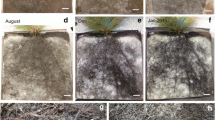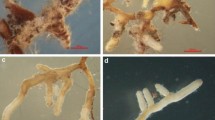Abstract
Tricholoma matsutake produces commercially valuable, yet uncultivable, mushrooms (matsutake) in association with pines in the Far East and Scandinavia and with both pines and oaks in the foothills of Tibet. Other matsutake mushrooms, such as Tricholoma anatolicum from the Mediterranean regions and Tricholoma magnivelare and Tricholoma sp. from the North Pacific Coast area of Canada and North America as well as Mexico, respectively, are associated with pines or oaks in their natural habitats. Tricholoma bakamatsutake and Tricholoma fulvocastaneum from Asia produce moderately valuable matsutake mushrooms and are solely associated with Fagaceae in nature. In this study, we demonstrate for the first time that matsutake mushrooms from Scandinavia, Mediterranean regions, North America, and Tibet form ectomycorrhizae with Pinus densiflora similar to the Far East T. matsutake. In general, worldwide T. matsutake and the symbionts of Pinaceae colonize the rhizospheres of P. densiflora as well as T. matsutake isolated from the host plant. However, T. fulvocastaneum and T. bakamatsutake formed a discontinuous Hartig net and no Hartig net, respectively, and colonized to a lesser extent as compared to T. matsutake. The data suggest that conifer-associated matsutake mushrooms in their native habitat will associate symbiotically with the Asian red pine.

Similar content being viewed by others
References
Agerer R (ed) (1987–2009) Color atlas of ectomycorrhizae. 1st–14th delivery. Einhorn-Verlag, Schwabisch Gmünd
Bao D, Koike A, Yao F, Yamanaka K, Aimi T, Kitamoto Y (2007) Analyses of the genetic diversity of matsutake isolates collected from different ecological environments in Asia. J Wood Sci 53:344–350
Bergius N, Danell E (2000) The Swedish matsutake (Tricholoma nauseosum syn. T. matsutake): distribution, abundance and ecology. Scan J For Res 15:318–325
Brundertt M, Bougher N, Dell B, Grove T, Malajczuk N (1996) Working with mycorrhizas in forestry and agriculture, Chapter 4.3. Measuring root colonisation by mycorrhizal fungi. Australian Centre for International Agricultural Research, Canberra, pp. 184–193
Bruns TD, Bidartondo MI, Taylor DL (2002) Host specificity in ectomycorrhizal communities: what do the exceptions tell us? Integ Comp Biol 42:352–359
Cairney JWG, Chambers SM (1999) Ectomycorrhizal fungi: key genera in profile. Springer, Berlin
Chapela IH, Garbelotto M (2004) Phylogeography and evolution in matsutake and close allies inferred by analyses of ITS sequences and AFLPs. Mycologia 96:730–741
Doç Y, Solak MH, Kalmiş E, Kalyoncu F (2007) Sedir Mantari. Ege University, Izmir
Gill WM, Guerin-Laguette A, Lapeyrie F, Suzuki K (2000) Matsutake—morphological evidences of ectomycorrhiza formation between Tricholoma matsutake and host roots in a pure Pinus densiflora forest stand. New Phytol 147:381–388
Guerin-Laguette A, Vaario LM, Gill WM, Lapeyrie F, Matsushita N, Suzuki K (2000) Rapid in vitro ectomycorrhizal infection on Pinus densiflora roots by Tricholoma matsutake. Mycoscience 41:389–393
Guerin-Laguette A, Shindo K, Matsushita N, Suzuki K, Lapeyrie F (2004) The mycorrhizal fungus Tricholoma matsutake stimulates Pinus densiflora seedlings in vitro. Mycorrhiza 14:397–400
Hamada M (1974) Matsutake nikki (diaries of matsutake). Kyoto University, Kyoto (in Japanese)
Hosford D, Pilz D, Molina R, Amaranthus M (1997) Ecology and management of the commercially harvested American matsutake mushrooms. USDA Forest Service PNG-GTR-412. USDA Forest Service, Washington
Imazeki R, Hongo T (1987) Colored illustrations of mushrooms of Japan, vol. 1. Hoikusha, Osaka
Intini M, Dogan HH, Riva A (2003) Tricholoma anatolicum spec. nov.: a new member of the matsutake group. Micol Veget Medit 18:135–142
Kobayashi H, Terasaki M, Yamada A (2008) Survival of Tricholoma matsutake mycelia on the root systems of Japanese red pine seedlings for a year after outplanting. Kanto-Shisniri-Kenkyu 59:325–326 (in Japanese)
Kytovuori I (1988) The Tricholoma caligatum group in Europe and North Africa. Karstenia 28:65–78
Lefevre C, Müller WR (1998) CDE18: Tricholoma magnivelare (Peck) Redhead+Pinus contorta Dougl. var. latifolia Engelm. Concise descriptions of North American Ectomycorrhizae. In Goodman DM, Durall DM, Trofymow JA, Berch SM (eds) Concise descriptions of North American Ectomycorrhizae, 4th folio. Mycologue, Sydney
Lim SR, Fischer A, Berbee M, Berch SM (2003) Is the booted tricholoma in British Columbia really Japanese matsutake? BC Journal of Ecosystem and Management 3:1–7
Masui K (1927) A study of the ectotrophic mycorrhizas of woody plants. Mem Coll Sci Kyoto Univ B III 2:152–279
Matsushita N, Kikuchi K, Sasaki Y, Guerin-Laguette A, Lapeyrie F, Vaario L-M, Intini M, Suzuki K (2005) Genetic relationship of Tricholoma matsutake and T. nauseosum from the Northern Hemisphere based on analyses of ribosomal DNA spacer regions. Mycoscience 46:90–96
Maurice J-P, Vairelles D, Jeandroz S, Le Tacon F (2003) Une Station à Tricholoma caligatum en forêt communale de greux (vosges). Bull Soc Mycol Fr 119:103–115
Murata H, Babasaki K (2005) Intra- and inter-specific variations in the copy number of two types of retrotransposons from the ectomycorrhizal basidiomycete Tricholoma matsutake. Mycorrhiza 15:381–386
Murata H, Babasaki K, Yamada A (1999) Identification of repetitive sequences with motifs of retrotransposons in the ectomycorrhizal basidiomycete Tricholoma matsutake. Mycologia 91:766–775
Murata H, Babasaki K, Miyazaki Y, Yamada A (2002) Genetic evidence that two types retroelements evolved through different pathways in ectomycorrhizal homobasidiomycetes Tricholoma spp. Biosci Biotechnol Biochem 66:1880–1886
Murata H, Babasaki K, Yamada A (2005) Highly polymorphic DNA markers to specify strains of the ectomycorrhizal basidiomycete Tricholoma matsutake based on σ marY1 , the long terminal repeat of gypsy-type retroelement marY1. Mycorrhiza 15:179–186
Murata H, Babasaki K, Saegusa T, Takemoto K, Yamada A, Ohta A (2008) Traceability of Asian matsutake, specialty mushrooms produced by the ectomycorrhizal basidiomycete Tricholoma matsutake, on the basis of retroelement-based DNA markers. App Environ Microbiol 74:2023–2031
Ogawa M (1978) The biology of matsutake. Tsukiji-shokan, Tokyo (in Japanese)
Ogawa M, Ohara H (1978) Microbial ecology of ‘Shiro’ in Tricholoma matsutake (S. Ito et Imai) Sing. and its allied species. VIII: Tricholoma bakamatsutake Hongo in Quercus mongolica var. grosserrata forest and Q. serrata forests. Trans Mycol Soc Japan 19:391–405 in Japanese
Otani Y (1976) Tricholoma bakamatsutake Hongo collected in New Guinea. Trans Mycol Soc Japan 17:363–365 (in Japanese)
Peter M (2006) Ectomycorrhizal fungi—fairy rings and the wood-wide web. New Phytol 171:685–687
Sanmee R, Fell B, Lumyong P, Lumyong S (2007) First record of Tricholoma fulvocastaneum from Thailand. Mycoscience 48:131–133
Singer R (1986) The Agaricale in modern taxonomy, 4th edn. Koeltz, Koenigstein
Smith SE, Read DJ (2008) Mycorrhizal symbiosis, 3rd edn. Elsevier, Oxford
Wang Y, Hall IR, Evans LA (1997) Ectomycorrhizal fungi with edible fruiting bodies 1. Tricholoma matsutake and related fungi. Eco Bot 51:311–327
Xu J, Sha T, Li Y-C, Zhao Z-W, Yang ZL (2008) Recombination and genetic differentiation among natural populations of the ectomycorrhizal mushroom Tricholoma matsutake from southwestern China. Mol Ecol 17:1238–1247
Yamada A, Kanekawa S, Ohmasa M (1999a) Ectomycorrhiza formation of Tricholoma matsutake on Pinus densiflora. Mycoscience 40:193–198
Yamada A, Maeda K, Ohmasa M (1999b) Ectomycorrhiza formation of Tricholoma matsutake isolates on seedlings of Pinus densiflora in vitro. Mycoscience 40:455–463
Yamada A, Ogura T, Ohmasa M (2001) Cultivation of mushroom of edible ectomycorrhizal fungi associated with Pinus densiflora by in vitro mycorrhizal synthesis II. Morphological description of ectomycorrhizas in open-pot soil. Mycorrhiza 11:67–81
Yamada A, Maeda K, Kobayashi H, Murata H (2006) Ectomycorrhizal symbiosis in vitro between Tricholoma matsutake and Pinus densiflora seedlings that resembles naturally occurring ‘shiro’. Mycorrhiza 16:111–116
Acknowledgments
We thank Hisashi Hada, Fukuzawa Fuminori, and Wanwisa Fangfuk of Shinshu University for technical assistance with the mycorrhization experiment and the DNA sequence of the cultured strains and M. Halil Solak of Muğla University for the guide to field sampling in Turkey. This study was partly supported by a grant-in-aid (no. 19380085) from the Ministry of Education, Culture, Sports, Science and Technology, Japan.
Author information
Authors and Affiliations
Corresponding author
Rights and permissions
About this article
Cite this article
Yamada, A., Kobayashi, H., Murata, H. et al. In vitro ectomycorrhizal specificity between the Asian red pine Pinus densiflora and Tricholoma matsutake and allied species from worldwide Pinaceae and Fagaceae forests. Mycorrhiza 20, 333–339 (2010). https://doi.org/10.1007/s00572-009-0286-6
Received:
Accepted:
Published:
Issue Date:
DOI: https://doi.org/10.1007/s00572-009-0286-6




